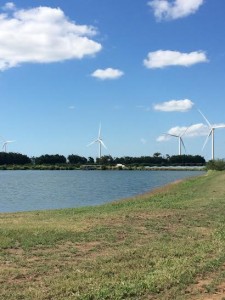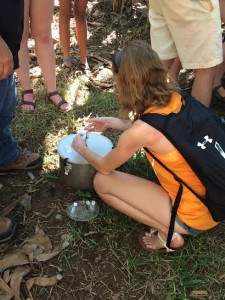After touring many different farms in Puerto Rico I have seen that there occur a lot of key differences when looking at the different parts of the agriculture production system in Puerto Rico and the United States that we can discuss in our booths. An obvious difference would be in the type of crops that are grown. In Illinois, the major crops are corn, soybeans and wheat while in Puerto Rico the main ones are coffee, plantain, sugarcane and tropical fruits. Additionally, the growing seasons vary tremendously. Since Puerto Rico maintains a fairly consistent climate all year, some farms have been able to accomplish a year-round growing season allowing more product to be sold. The United States’ seasons are severely shortened by the varying temperatures throughout the year. The ways these crops are harvested differ between the two places. For example, in the United States there is a machine for harvesting almost every kind of crop while in Puerto Rico most of the produce is collected by hand. Looking at the livestock side of agriculture, there is almost none in Puerto Rico. The livestock is so poor in Puerto Rico that no one wants to have any. Coming from an animal farm, I find the differences in the small amount of livestock that there is fascinating. The fact that these animals can be specifically bred to withstand the heat of Puerto Rico is exceptional to me.
Where Puerto Rico has the edge over the United States is in their agricultural practices that are safer for the environment. Some of the managers of Martex farms explained to us some of the methods that they use to protect the beautiful nature in Puerto Rico. They use a lot of solar and wind energy to power their operation as seen in the picture below. They recycle the poorer quality fruit as feed for their cattle. We observed more techniques at the coffee farms. They let the sun dry their beans to save fossil fuels. Their fertilizer comes from the discarded shells on the beans. It seems that farms in Puerto Rico do not use chemicals that often which is different from most of the farms in the United States. I think that in terms of being environmentally friendly the United States could learn a lot from the farmers in Puerto Rico.
I believe what Martex Farms is doing with the University of Puerto Rico is very important. They are working together to conduct experiments that are going to reduce the amount of nitrogen that they apply. They let us take part in the experiment as seen in the photo below. Experiments like these are imperative because they educate the people of Puerto Rico about agriculture and can help repair the industry in Puerto Rico. A lot of the people of Puerto Rico have a negative view of agriculture because of the poor following it has. This collaboration between Martex and the university is the start of fixing this negative connotation. The same goes for the studies that the University of Illinois is doing as well. They can both help mend the bad reputation that farmers are starting to get in both areas.
While talking to people about our experiences during our study in Puerto Rico, I think it is important to explain how the issues that we are facing in the United States are global issues and not just national issues. Climate change has had some major impacts in both places. In Puerto Rico it is changing the growing seasons for many crops especially coffee. This has resulted in an extreme drop in the amount of crop produced. In Illinois the seasons have differed greatly from year to year by going from droughts to floods or scalding heat to frigid cold which has, in turn, impacted the planting and harvesting of crops. Also, consumer issues are evident in both environments. Both places are fighting the war of local versus commercial food. Knowing that these are shared issues can help reach a solution quicker.



